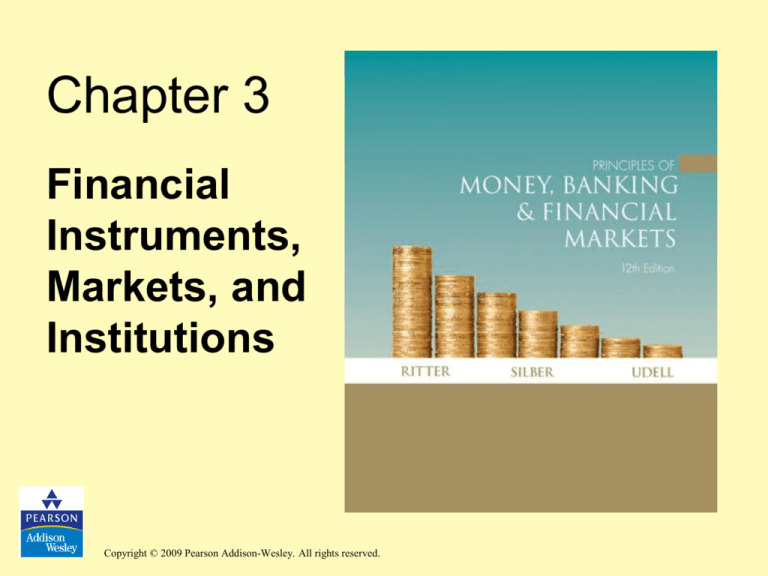
Chapter 3
Financial
Instruments,
Markets, and
Institutions
Copyright © 2009 Pearson Addison-Wesley. All rights reserved.
Learning Objectives
• Envision the flow of funds between savers
and borrowers in a modern macroeconomy
• Describe the basic differences between debt
and equity and how these tools facilitate the
flow of funds between savers and borrowers
• Identify how financial intermediaries assist
the transfer of funds from lenders to
borrowers
Copyright © 2009 Pearson Addison-Wesley. All rights reserved.
3-2
Flow of Funds
• Financial system provides a transmission
mechanism between saver-lenders and borrowerspenders.
– Savers benefit—earn interest
– Investors benefit—access to money otherwise not
available
– Economy benefits—efficient means of bringing
savers and borrowers together
Copyright © 2009 Pearson Addison-Wesley. All rights reserved.
3-3
Flow of Funds (Cont.)
• Funds flow indirectly from ultimate lenders
[households] through financial intermediaries [banks
or insurance companies] or directly through financial
markets [stock exchange/bond markets] to ultimate
borrowers [business firms, government, or other
households]
(See Figure 3.1)
• In order for financial system to function smoothly, must
be adequate information about the markets and their
operation
Copyright © 2009 Pearson Addison-Wesley. All rights reserved.
3-4
FIGURE 3.1 Flow of funds from
lenders to borrowers.
Copyright © 2009 Pearson Addison-Wesley. All rights reserved.
3-5
Financial Instruments and Markets
• Primary Markets
– Market for issuing a new security and distributing to saverlenders.
– Investment Banks—Information and marketing specialists
for newly issued securities.
• Secondary Markets
– Market where existing securities can be exchanged
• New York Stock Exchange
• American Stock Exchange
• Over-the-counter (OTC) markets
Copyright © 2009 Pearson Addison-Wesley. All rights reserved.
3-6
Financial Instruments and Markets
(Cont.)
• Bonds Represent Borrowing
– Agreement by issuer to pay interest on specified dates and
redeem the bond upon maturity.
– Consols—Bond with no maturity date, pay interest forever
– Coupon Securities—Attached to bond and sent in to collect
interest [generally semi-annually]
– Zero-coupon—Sold at price well below face value. Collect
interest when the bond matures.
– Tax Exempt—Interest earned is not taxed (issued by state,
local, or municipal governments).
Copyright © 2009 Pearson Addison-Wesley. All rights reserved.
3-7
Financial Instruments and Markets
(Cont.)
• Stocks Represent Ownership
– Stockholder owns part of the corporation and receives
dividends from the issuer.
– No government stock—individuals cannot “own” part of the
government
– Types of Corporate stocks
• Preferred Stock—Fixed dividends, priority over common stock
• Common Stock—Variable dividends, based on company’s profits.
• Convertible—Convert preferred into common at a stated price
Copyright © 2009 Pearson Addison-Wesley. All rights reserved.
3-8
Financial Instruments and Markets
(Cont.)
• Stocks Represent Ownership (Cont.)
– Like bonds, existing stock may be exchanged through
secondary markets.
– Capital Gains—Difference between price initially paid and
amount received when stock is sold.
– Measures of trends in overall common stock prices
• Standard & Poor’s 500 Stock Index—based on prices of 500
individual stocks
• NASDAQ Composite Index—based on all stocks listed in NASDAQ
• Dow Jones Industrial Average—based on price of 30 “blue-chip”
stocks
Copyright © 2009 Pearson Addison-Wesley. All rights reserved.
3-9
Financial Instruments and Markets
(Cont.)
• Both stocks and bonds [securities] represent a
claim to a stream of payments [cash flows] in
the future
– Bonds—Interest payment and face value at maturity
– Stocks—Dividends and sales price when sold
Copyright © 2009 Pearson Addison-Wesley. All rights reserved.
3-10
Financial Instruments and Markets
(Cont.)
• Mortgages Involve Real Estate
– Debt incurred in order to buy land or building
– Amortized—principal and interest is gradually repaid over
the life of loan
– Fixed Rate—Rate of interest is fixed
– Variable-Rate—Rate of interest varies depending on
financial environment
– Cash flow for lender is uncertain
• Interest payments may vary [variable rate mortgages]
• Home owner may prepay
• Refinance a fixed mortgage if interest rates decline
Copyright © 2009 Pearson Addison-Wesley. All rights reserved.
3-11
Financial Instruments and Markets
(Cont.)
• Mortgages Involve Real Estate (Cont.)
– Securitization—Individual mortgages may be
“pooled” and sold as a unit to reduce uncertainty.
– Mortgages may be insured by government
agencies—Federal Housing Authority (FHA) or
Veterans Administration (VA)
Copyright © 2009 Pearson Addison-Wesley. All rights reserved.
3-12
Financial Instruments and Markets
(Cont.)
• Derivatives: Options and Futures Contracts
– Contractual agreement between two parties to exchange a
third asset in the future at a stated price
– Often called derivative financial instruments because they
derive value from underlying assets
– Long—Buyer of the contract, receive commodity in the
future
– Short—Seller of the contract, provide commodity in the
future
– Speculators gamble on price fluctuations and hope to profit
– Eliminate the risk of price fluctuations
Copyright © 2009 Pearson Addison-Wesley. All rights reserved.
3-13
Financial Instruments and Markets
(Cont.)
• The Capital Market
– Exchange of long-term securities—in excess of one year
– Generally used to secure long-term financing for capital investment (Table
3.1)
• Stock market—Largest part of capital market and held by private and
institutional investors
• Residential and commercial mortgages—Held by commercial banks and
life insurance companies
• Corporate bond market—Held by insurance companies, pension and
retirement funds
• Local and state government bonds—Primarily held for tax-exempt feature
• Government securities—Held by commercial banks, the Fed, individual
Americans/foreigners, and dealers
Copyright © 2009 Pearson Addison-Wesley. All rights reserved.
3-14
Financial Instruments and Markets
(Cont.)
• The Money Market
– Exchange of short-term instruments—less than one year
– Highly liquid, minimal risk
– Use of a temporary surplus of funds by banks or businesses
(Table 3.2)
• Commercial paper—short-term liabilities of prime business firms
and finance companies
• Bank Certificates of Deposits—liabilities of issuing bank, interest
bearing to corporations that hold them
• U.S. Treasury bills—short-term debts of US government
Copyright © 2009 Pearson Addison-Wesley. All rights reserved.
3-15
Financial Intermediaries: Purposes
and Profile
• Role Financial Intermediaries
– Act as agents in transferring funds from savers-lenders to
borrowers-spenders.
– Acquire funds by issuing their liabilities to public and use
money to purchase financial assets
•
•
•
•
Earn profits on difference between interest paid and earned
Diversify portfolios and minimize risk
Lower transaction costs
Competition lowers interest rates—beneficial to economic growth
Copyright © 2009 Pearson Addison-Wesley. All rights reserved.
3-16
Financial Intermediaries: Purposes
and Profile
• Financial Institutions in Profile—focus on
composition of liabilities and assets
– Commercial Banks
• Most prominent
• Range in size from huge (BankAmerica) to small (local banks)
• Major source of funds used to be demand deposits of public, but now
rely more on “other liabilities”
• Also accept savings and time deposits—interest earning
Copyright © 2009 Pearson Addison-Wesley. All rights reserved.
3-17
Financial Intermediaries: Purposes
and Profile (Cont.)
• Financial Institutions in Profile (Cont.)
– Commercial Banks (Cont.)
• Purchase wide variety of assets
– short-term government securities
– long-term business loans
– home mortgages
Copyright © 2009 Pearson Addison-Wesley. All rights reserved.
3-18
Financial Intermediaries: Purposes
and Profile (Cont.)
• Financial Institutions in Profile (Cont.)
– Life Insurance Companies
• Insure against death
• Receive funds in form of premiums
• Use of funds is based on mortality statistics—predict
when funds will be needed
• Invest in long-term securities—high yield
– Long-term corporate bonds
– Long-term commercial mortgages
Copyright © 2009 Pearson Addison-Wesley. All rights reserved.
3-19
Financial Intermediaries: Purposes
and Profile (Cont.)
• Financial Institutions in Profile (Cont.)
– Pension and Retirement Funds
•
•
•
•
Concerned with long run
Receive funds from working individuals building “nest-egg”
Accurate prediction of future use of funds
Invest mainly in long-term corporate bonds and high-grade stock
– Mutual Funds
• Stock or bond market related institutions
• Pool funds from many people
• Invest in wide variety of securities—minimize risk
Copyright © 2009 Pearson Addison-Wesley. All rights reserved.
3-20
Financial Intermediaries: Purposes
and Profile (Cont.)
• Financial Institutions in Profile (Cont.)
– Money Market Mutual Funds
• Individuals purchase shares in the fund
• Fund invests in highly liquid short-term money market
instruments
– large-size negotiable CD’s
– Treasury bills
– high-grade commercial paper
Copyright © 2009 Pearson Addison-Wesley. All rights reserved.
3-21
Financial Intermediaries: Purposes
and Profile (Cont.)
• Financial Institutions in Profile (Cont.)
– Savings and Loan Associations [S&L’s]
• Traditionally acquired funds through savings deposits
• Used funds to make home mortgage loans
• Now perform same functions as commercial banks
– issue checking accounts
– make consumer and business loans
– Commercial and Consumer Finance Companies
• Acquire funds primarily by selling short term loans (commercial
paper)
• Lend money for consumer purchases or business firms to finance
inventories
Copyright © 2009 Pearson Addison-Wesley. All rights reserved.
3-22
Financial Intermediaries: Purposes
and Profile (Cont.)
• Financial Institutions in Profile (Cont.)
– Property and Casualty Insurance Companies
•
•
•
•
Insure homeowners and businesses against losses
Receive premiums
Need to be fairly liquid due to uncertainty of claims
Purchase a variety of securities
– high-grade stocks and bonds
– short-term money market instruments for liquidity
Copyright © 2009 Pearson Addison-Wesley. All rights reserved.
3-23
Financial Intermediaries: Purposes
and Profile (Cont.)
• Financial Institutions in Profile (Cont.)
– Credit Unions
• Organized as cooperatives for people with common
interest
• Members buy shares [deposits] and can borrow
• Changes in the law in early 1980’s broadened their powers
– checking [share] accounts
– make long-term mortgage loans
Copyright © 2009 Pearson Addison-Wesley. All rights reserved.
3-24
TABLE 3.1 The Capital Market:
Securities Outstanding (2007)
Copyright © 2009 Pearson Addison-Wesley. All rights reserved.
3-25
TABLE 3.2 The Money Market:
Securities Outstanding 2007
Copyright © 2009 Pearson Addison-Wesley. All rights reserved.
3-26
TABLE 3.3 Financial Institutions,
Ranked by Asset Size (2007)
Copyright © 2009 Pearson Addison-Wesley. All rights reserved.
3-27







